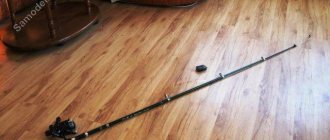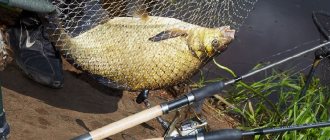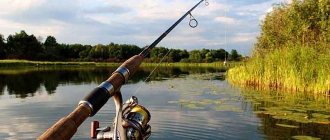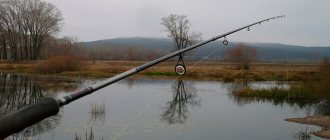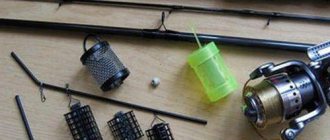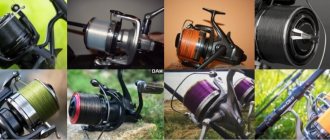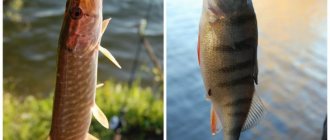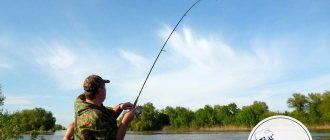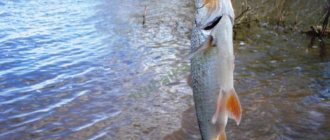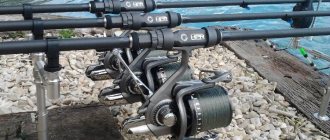Feeder versus spinning rod (video)
Related articles:
| Choosing a coil for a feeder | Shimano feeders review | Feeder accessories |
| Do-it-yourself bait | Preparing makushatnik | Fishing on flat feeders |
| DIY feeder feeders | Review of hooks for feeder fishing | How to choose a feeder rod |
| DIY fishing crafts With your own hands 16 thousand views | |
| Rating of winter spinners for perch fishing Winter fishing 13 thousand views | |
| Review of the best balancers for ice fishing Winter fishing | |
| Fishing with jigs: varieties, gear, fishing techniques Winter fishing 19 thousand views | |
| Types of fish finder echo sounders for fishing Echo sounders 19 thousand views | |
| Review of aluminum fishing boats Boats 14 thousand views | |
| Review and rating of echo sounders for fishing Echo sounders 7 thousand views | |
| How to choose a spinning reel? Reels 10 thousand views | |
| Electric motors for inflatable boats (review) Motors 3 thousand views | |
| Aluminum fishing boats Boats 8 thousand views | |
| Which coil to choose for a feeder - overview of characteristics Feeder 19 thousand views | |
| Characteristics and capabilities of feeder rods Feeder 6 thousand views | |
| Rating of carp reels with baitrunner Carp fishing 9 thousand views | |
| Fishing boat: what to look for when purchasing Boats 21 thousand views | |
| How to choose a motor for a boat? Motors 3 thousand views | |
| Classification of wobblers and other baits Spinning 30 thousand views | |
| Fishing with silicone baits Spinning 15 thousand views | |
| The best wobblers for pike: size, color, wire Spinning 4 thousand views | |
| Feeder fishing on flat feeders Feeder 8 thousand views | |
| Homemade bait for bream with your own hands Feeder 21 thousand views | |
| Spinning fishing with rattlins Spinning 3 thousand views | |
| How to choose a carp reel: review and rating Carp fishing 14 thousand views |
This is interesting: What is the difference between a feeder and a picker?
Test and rod length
When choosing feeder rods, you should evaluate the conditions in which it will be used. Each manufacturer indicates on the form the test, i.e., the weight range of the feeder. By correlating it with the length of the fishing rod, you can understand how to choose the right feeder rod from their 5 options.
Ultra-light (Picker) has a length of only 2-3 m, and its test is in the range of 10-40 g. It is suitable for fishing in water without current.
The light feeder reaches a length of 3 to 3.6 m with a test load of up to 60 g. It can be used in small currents.
The medium rod has a length of up to 3.6 m, but its test is higher than the light version. It reaches 100 g. This equipment will help you catch carp and drag it safely to the shore.
For carp fishing, both for beginners and professional fishermen, a Heavy type feeder rod will be the right choice. Its length reaches 3.9 m, and the test is 120 g.
To determine what length to choose a feeder rod for a wide river with a very fast current, you should pay attention to the Extra Heavy type. By choosing this length of the feeder rod, you can catch the largest carp at a great distance from the shore.
Main differences
By fishing method
Spinning fishing is fundamentally different from feeder fishing. The latter is much calmer and unhurried, most of the time the tackle rests peacefully on the stand, waiting for a bite, and casts occur mainly when a new portion is delivered to the feeding area.
Spinning fishing is entirely based on constant casting and retrieving; there is no room for expectations or doubts. The entire fishing process, not just hooking and fishing, depends on the activity of the fisherman.
The detection of bites in feeders occurs thanks to a special rod tip - a quivertip. The quivertip is very flexible and sensitive; observing its movement allows you to determine the moment of a bite.
With a spinning rod, due to the design of the rod, the detection of a bite occurs due to the vibrations of the entire tackle that the fisherman holds in his hand, that is, the bite is felt by the fisherman not visually, but tactilely.
The sensitivity of a quivertype is expressed in ounces. It is equal to the number of ounces required to bend the quiver tip 90°. The lower this number, the more mobile the tip. The “tightest” tips have a sensitivity of 6.
Also, the tips differ in rigidity:
- soft ones are used in standing water;
- medium ones are used for minor currents or low winds;
- rigid ones are used in reservoirs with strong currents.
Therefore, depending on the conditions and the object of fishing, when using a feeder, you should have with you a set of tips with different sensitivity and rigidity.
What is a spinning rod system?
By rod design
Spinning rods have shorter rods than feeder rods. The reason for this is the convenience for active fishing: spinning anglers have to cast the tackle up to hundreds of times, and its large dimensions and weight will lead to the fact that the fisherman will get tired faster.
In addition, fishing with a spinning rod can be carried out both from the shore and from a boat, and the use of too long and heavy gear in this case causes great inconvenience.
Feeder fishing does not have a similar frequency of casts, since the time between casts is much longer. It is determined by the duration of dissolution of the bait in the input.
The length of spinning rods rarely exceeds 2.5–3 m; feeders can reach lengths of up to 5 m (although 2.7 to 4.2 m are predominantly used). This length is necessary not only for casting over long distances, it allows you to land fish through a hard edge. Using a long rod, you can “pull” the fish higher, passing it over the edge to avoid snagging.
The difference between a spinning rod and a feeder is also in the number of throughput rings. To ensure uniform load along the entire length of the rod, the number of feeders is greater.
According to the test
Due to the greater weight of the bait, tests for feeders are greater than for spinning rods. Heavy class spinning has a test from 40 g and above (mostly up to 60 g, very rarely up to 100 g), while the test for a medium-light feeder starts from 60 g.
When using a spinning rod as a feeder, you should choose a rod with some margin of strength, because even the lightest bait feeders will weigh 50–60 g, and casting them can easily break the rod.
This is especially critical for spinning rods, since, given their small length (no more than 2.7 m) and relative lightness, casting bait over long distances will require a power cast. At the same time, the likelihood of breaking an overloaded tackle increases significantly. At the same time, the shortest feeder with a length of only 3 m allows you to easily throw heavy baits over long distances without any breakdowns.
By formation
Mostly spinning rods are characterized by a fast or ultra-fast action. Feeders, on the contrary, have either a slow or complex structure (with small loads, only the tip bends, with increasing loads, the entire form bends). Light and ultra-light feeders (the latter are called pickers) can also have a fast action.
By reel
When feeder fishing, mostly inertia-free reels with a clip are used. The clip allows you to accurately measure the length of line required for casting.
In addition, feeder reels are traditionally heavier and are predominantly made of metal. Spinning reels, which work much more often due to the greater number of casts, are usually lighter. Feeder reels are equipped with an improved transmission link mechanism, which is not critical in spinning reels.
Gear ratios of feeder fishing reels are usually selected in the range from 4.5 to 5.2, since larger or smaller values are irrational.
For spinning rods, this parameter can vary widely, since it depends on the size of the predator or the nature of the fishing.
Rod build
The structure of a feeder rod when choosing for beginning fishermen should be one of the main parameters. It makes it clear what rigidity (elasticity) the body of the tackle has.
A fast action belongs to a stiff rod. When loaded, only the top and first knee of the product will bend. This action is considered the best when choosing a feeder rod for carp. When the fish goes behind the snags, this quality will allow you to control it during the fishing process.
The slow action allows the rod to bend at all knees, which will prevent the leader from breaking.
And here's what you need to know: Daiwa Team Daiwa TD-AR 862 MHFS spinning rod (2.59 m
https://www.youtube.com/watch?v=JWhqzYBJ_7w
To decide how to choose a feeder rod for beginners, you should purchase a product with a complex action. Such a tackle will bend only at the top under light loads, and with strong resistance from a large fish, all its knees will move. This will allow you to determine which feeder rod for carp fishing will be more comfortable for the fisherman.
Comparison of key indicators
It is necessary to compare the differences between a feeder rod and a spinning rod, starting with the main parameters characteristic of each of them. The first thing to understand is that these types of forms have fundamentally different purposes. However, everything is not so simple here either. When studying how a feeder differs from a spinning rod, it is worth comparing their main characteristics.
- Purpose. For feeders, this is fishing with bottom gear. Spinning rods are used for sport fishing using artificial baits.
- Casting distance. Here the difference is especially great. Feeders are real champions in this matter, capable of sending gear 100-120 meters. The range of application of spinning rods is much narrower. It is suitable for fishing from a boat or casting bait a few meters from the shore.
- Construction type. Almost all of the most popular models of spinning rods are plug-in, composite, with several elements of equal length. Feeders can be telescopic. But more often they are also plug-in, made up of 2-3 parts.
- Length. For spinning rods it varies from 1.8 to 3.3 m. Feeders have a length of 3 meters.
- Build. The differences here are significant. Spinning blanks usually have a fast or super-fast action, but can also be produced in a medium or slow version. The feeders are equipped with interchangeable tips - quivertips, which allow you to change the tuning. In general they are considered slower and softer than spinning rods.
- Test. For comparison, you can take middle class rods. For spinning rods this will be Moderate with indicators of 15-40 g. For feeders - medium feeder with a test of 80-100 g. The difference lies in the maximum weight of the load that the blank can support when casting.
- Sensitivity. With a spinning rod, bite alarms are practically not needed - holding the tackle in your hands, you can easily feel the right moment. The feeder form has a tip that allows you to mark the fish notch. But in terms of sensitivity, it is noticeably inferior to its sports counterparts.
- The number of throughput rings. The feeder has more of them, and this is due not only to the increased length of the rod, but also to the need to secure the fishing line in a certain position.
These are the main characteristics by which you can find the differences between feeder gear and spinning rods. In addition, there is a difference in the use of different types of gear.
How to choose a feeder rod for a beginner
So, we have already found out that for a beginner, heavy class rods with a test weight of up to 100 g are preferable. This will allow a beginner to fish different bodies of water in the most different conditions and fish of different sizes. The universal rod length for a beginner will be 3.6-3.9 meters. Build parabolic or fast. The material is composite or carbon fiber. For a beginner, a quivertip is definitely better from feederglass, which will “forgive” most mistakes, including when playing.
The option of a telescopic rod would be quite acceptable, however, if it is possible not to take inexpensive poles, then it is better to immediately get used to a good plug rod. The handle will fit 50 centimeters from cork.
Based on all the parameters, we selected an approximate model of a feeder rod (not an advertisement, presented solely as an example) - Volzhanka Optima 3.6.
Volzhanka Optima 3.6 meters, plug-in
Characteristics.
Includes 3 quivertypes and a case.
Price: 3150 rubles (price in 2021).
Video about the main points in choosing a feeder rod, answers to all basic and specific questions:
Are there any differences in operation?
3
Feeder fishing involves a wait-and-see fishing tactic. This means that the rod will spend most of its time on a special stand. Feeders allow you to deliver over considerable distances not only the tackle itself, but also other necessary components - traps, bait, bait. These forms are used to catch bottom fish.
Feeder fishing technology is significantly complicated by the presence of the stage of feeding fish. The fishing process is divided into several stages.
- Choosing a casting location. A specific landmark on the ground is chosen for it. Perform test casts.
- Innings. The feeder is filled with the selected ingredients. Throws into the fishing point. In this case, after splashdown, the line guide is closed, the monofilament or braid used is pinched with a clip. This way you will be able to maintain casting accuracy in the future.
- Feed dump. When the feeder reaches the bottom, the tension in the line will disappear. Next, you need to make a sharp jerk, releasing its contents, and pull the equipment ashore. The number of such casts, depending on the stocking of the reservoir and the intensity of the bite, can reach 8-10.
- Change of equipment. Instead of a feeder, a leash with a hook is fixed for installation. The nozzle is attached to it.
- A cast is made to the feeding area.
- The rod is placed on the stand. All that remains is to wait for the signal from the tip about the bite, hook and pull out the fish.
This is exactly how feeder fishing happens. The main key to its success is the feeding stage. The more abundantly the food is supplied, the sooner the bite will occur. In addition, it is important to take into account the choice of bait according to the season and food preferences of the fish.
Spinning is a tool for active fishing. You almost always have to hold it in your hands. In addition, during operation, regular fishing of the water area is carried out, and casting is carried out.
Working with a spinning rod involves constantly using the reel, winding and releasing the fishing line.
The technique of fishing with a spinning rod begins with determining the fishing location. Next, the type of bait is determined - jig, spinner, wobbler, and wiring is performed. Bites usually occur during pauses between the play of the bait. They feel like a poke of a form into your palm. After this, you need to hook the fish, begin to fish out the fish, tiring it, and then use a landing net to pull it to the surface.
Apex (quivertype)
A distinctive feature of the feeder from a conventional spinning rod is the presence of replaceable tops. They signal the fisherman about a bite. Usually 3-4 tops are supplied with the feeder.
This element has its own test. The color indicates the stiffness of the quivertype. The red top is the stiffest, the orange or hard top has medium flexibility, and the green top is the softest.
The type of top is selected in accordance with the conditions of the reservoir. If the current is strong, you should choose rigid quivertips. The soft elements of the rod will be able to more accurately convey the signal of a bite in calm water without waves or currents.
And here's what you need to know: Light spinning rod for twitching - About fishing
If the quivertype breaks due to an accidental impact or severe bending, you can pick up an identical product in the store. When choosing, you should take into account the diameter of the base. It must correspond to the value specified by the manufacturer.
Which is better to choose?
Using a feeder instead of a spinning rod seems to be a rather complicated undertaking. It is physically difficult to hold a heavy long-range rod suspended for a long time. In addition, bottom equipment is not very suitable for catching predators in shallow water. Another thing is spinning, which craftsmen quite successfully adapt to feeder fishing conditions. Of course, results in this matter can only be achieved if the fisherman has a feeder and leashes with hooks in his arsenal, otherwise nothing will work.
The main difficulty in catching bottom fish with a spinning rod is its low sensitivity compared to a feeder. The vertex as a signaling device turns out to be useless here. But you can make an adapter from a tube, with the help of which a standard quivertip of the required size is fixed to the spinning rod.
This universal tackle has both the possibility of a feeder and classic spinning characteristics.
As for the choice in favor of one or another rod option, a lot depends on personal preferences. Spinning rods are usually chosen by those who expect the drive from fishing that is characteristic of the sports version. A variety of artificial baits and fishing rods are used here, and the fishing rod practically never leaves the owner’s hands. This is the optimal choice for those who want to improve their skills, try and master new fishing patterns and methods.
Feeder fishing is a classic, allowing you to leisurely spend time on the shore waiting for decent catch. Such forms are chosen for catching bottom dwellers who prefer natural food. Preparing groundbait and bait for the feeder requires more time and effort. This option is suitable for fans of multi-day trips who want to experience all the features of fishing.
When choosing a fishing rod, it is important to consider the fishing method. For example, a long feeder is not very convenient for use from a boat. This is a classic coastal tackle. Spinning, on the contrary, can be adapted to different conditions - it allows you to catch fish in open water with different current levels.
What is the difference between a feeder and a spinning rod, see the video below.
This is interesting: Feeder for long casting
What is the difference between a feeder and a donkey?
An interesting fishing question is what is the difference between a feeder and a donkey. Traditional bottom tackle based on spinning is now being actively replaced by feeder equipment. Progressive bottom fishing is becoming increasingly popular among our anglers. The confrontation on the Internet between feeder and donkey is actively discussed. In this article we will find out which is better, a feeder or a donk in traditional equipment. Let's look at how these fishing methods differ in tactics, technique and equipment.
Choosing a spinning rod for a feeder
Along with classic spinning fishing, feeder spinning fishing is gaining popularity.
Translated from English, “feeder” means “feeder.” This idea originated in England. Simply put, food is served to the fish in a special feeder. And there the hooks with attachments are already waiting. A modern version of fishing with a feeder is called quivertip. Only special blanks are used, match ones with a very sensitive tip. The latter plays the role of a bite alarm.
There are differences between spinning and feeder forms. Although these differences do not prevent you from fishing with a spinning rod as a feeder, or with a feeder as a spinning rod.
In a spinning rod, the strength and elasticity of the rod should exceed that of float rods. A simple spinning cast is sometimes on the verge of the strength of the tackle material.
Modern rods for spinning tackle are made of carbon fiber and carbon fiber with the addition of boron fibers, which create additional flexibility. The most common products now are made from multilayer composite with the addition of graphite. They have the inscription "CARBON" on them.
Passing rings
The guide rings are subject to heavy loads when fishing. Their quality and strength play an important role for the feeder.
High-quality rings are often produced by independent manufacturers. Therefore, the Salmo feeder may have Fugi rings. Quality products are also produced by Balzer and DAM.
When wondering how to choose a feeder rod, you should pay attention to the fastening of the guide rings. In good quality products, these elements are mounted on three legs.
Inserts inside the rings can extend their service life.
What is spinning?
Spinning is the best option for successfully catching fish, especially predatory ones. But in order for there to really be success, spinning requires a certain amount of knowledge and practical skills . It is optimal if, with the purchase of your first spinning rod, you receive information support from a more knowledgeable and experienced fisherman. Further, it is quite possible to “upgrade” the gear independently, without outside help, but basic knowledge is required.
Spinning
Before you go to a specialized store to make a purchase, you need to delve into the theoretical part and description of the spinning rod itself. It is necessary to understand the principle of its operation, its possible varieties, and study the technologies that are often present in the production process.
Depending on the design, the spinning rod can be telescopic or plug-in. Telescopic rods are better suited for beginner fishermen because they:
- Significantly cheaper than the plug version.
- Lungs.
- Less bulky.
- Folds up great.
- Much more convenient than plug-in ones during operation.
Spinning telescopic
Those who already have significant experience in fishing choose models like feeder gear for the following reasons:
- There is no significant weight at the docking point.
- Excellent elasticity indicators.
- High degree of sensitivity.
- Individual placement of rings.
Plug spinning rod
Depending on the material from which the tackle is made, spinning rods come from:
- Composite.
- Fiberglass.
- Carbon fiber.
The latter option is popular among professional fishermen and those involved in sport fishing. They also recommend choosing the right spinning rod test when purchasing. For beginners, the test is the parameters that determine the weight of the bait. As a rule, the indicator consists of two numbers, the first is the reaction of the rod to the minimum possible weight of the bait, the second is the indicator of the maximum weight of the bait.
There is also a rod construction parameter. It implies the degree of response to external actions. The structure can be:
- Slow (the whole rod bends)
- Medium (half of the rod bends)
- Fast (top bends)
In order to choose the best option, you must first of all have the necessary amount of information and understand the purpose of purchasing gear.
Which feeder to choose?
- Bait - for primary feeding of fish, attracting them to the fishing spot. Holds a large volume of feed, has large holes for its quickest rinsing;
- Feeder for long-distance casting - similar to a badminton shuttlecock, good for casting to the right place;
- Supplementary feeding - good in still water and in currents, has different cells for slowly washing out the feed. Its task is to keep the fish in one place for a long time.
Choice of bait
The success of feeder fishing depends on well-chosen bait. The bait is based on various cereals and cakes. They also add aromas and worms. Each fisherman has his own secrets for preparing bait.
The feeder is filled at the fishing site and always with fresh food. An exception may be fishing for carp, which is called “water pig” because of its omnivorous nature. Throw a feeder with hooks attached to it to a possible location of fish. Fixed on a stand at an angle to the plane of the water. This makes it more convenient to watch the moment of the bite.
Feeder
When determining how to choose a feeder rod for carp fishing, you should pay attention to its feeder. It was this element that gave the name to the tackle itself and the fishing method in general.
Weight and shape of product shown may vary. The most commonly used in feeder fishing is the rectangular feeder. It is used on all types of reservoirs. If the current is quite strong, they opt for triangular types of feeders. For calm waters, round varieties can be used.
Feeders weighing about 50 g are considered universal. To understand how to choose a feeder rod, you should correlate the weight of the feeder with the test form and the flow of the reservoir. For calm water, the presented rod element weighing 30 g is suitable, and for strong currents - from 100 g and above.
What is a feeder rod?
A type and optimized bottom tackle is considered to be a feeder rod. The main features of the feeder are the presence of a sensitive tip, which instantly reacts to a bite. There is a feeder classification:
- Easy class.
- Middle class. The most popular one is used by professional fishermen and is suitable for beginners.
- Hard class.
- Ultralight class (picker).
- Super heavy class (for fishing in difficult conditions).
Feeder rod
Like a spinning rod, a feeder rod is characterized by test indicators . You should not deviate from the test parameters when choosing a form. It is better not to reach the maximum indicator with a margin of 10 g. The feeder rod visually consists of three or four components, and can reach up to 4 meters in length. The tip is always marked with a bright color to attract fish and increase the bite. The length is chosen depending on the place of fishing. The longest ones are designed for fishing in reservoirs or deep and large lakes. For shallow rivers, three-meter feeders are suitable.
As with marking a spinning rod, feeders have an action parameter. The longer the rod, the higher the action, and light and short, the slow and medium. But manufacturers prefer to produce fast tuning, medium tuning very rarely, and slow tuning which is rarely seen at all.
What is the difference between a spinning rod and a feeder rod?
Feeder and spinning rods are designed for catching fish; they have the same purpose. But, there are significant differences in the methodology and area of their use. Feeder rods and spinning rods are designed for completely different types of fishing. Feeder, after casting you can put it on the stand and wait for a bite. The spinning rod must be held in your hands at all times.
A feeder rod is much heavier and longer than a spinning rod. In addition, fishing with a spinning rod is much more active than when using a feeder. You can change the tips on the feeder, which indicate flexibility and the degree of bite; the spinning rod has no removable parts. What type of gear to choose is a purely individual question, which depends on preferences, type of fish, type of water body and financial capabilities.
Cloudflare Ray ID: 63a7da13f93ffa78 • Your IP: 195.64.208.251 • Performance & security by Cloudflare
Cloudflare Ray ID: 63a7da14f9341665 • Your IP: 195.64.208.251 • Performance & security by Cloudflare
Cloudflare Ray ID: 63a7da157d3ec785 • Your IP: 195.64.208.251 • Performance & security by Cloudflare
For successful feeder fishing, an angler must know all the accessories for such fishing. Feeders can be factory-made or home-made. Its role is to deliver food to the place where the fish are located. It is both a bait for bottom inhabitants and a place for them to feed.
Spinning rods for feeder fishing
Feeder and spinning rod have significant differences because they are designed for different types of fishing. In general, it is impossible to use a spinning rod as a feeder rod. But the use of spinning rods for feeder fishing, although it has some limitations, is quite possible and appropriate. Let's look at the difference between a feeder and a spinning rod and how these two types of rods can be used to replace one with the other.
Is there a significant difference between a spinning rod and a feeder?
Both the spinning rod and the feeder are designed equally for successfully catching fish, especially predatory ones. In order for it to be successful, you must have some knowledge and practical skills in this gear.
When purchasing a spinning rod, you do not need to deviate from these parameters. When planning a spinning fishing trip with a feeder, you need to choose a spinning rod with a safety margin. This gear is designed for fishing from the bottom.
Both spinning rods and feeder forms have their own structure. The longer the whip, the higher the action indicator. These rods are suitable for long casting on lakes.
Feeders are also distinguished by a large number of passage rings; they provide the load evenly along the entire length of the form.
Vershinki
The main difference between a feeder and a spinning rod is the replaceable tip. There are several different hardnesses included when purchasing. It can then be attached to a spinning rod. Otherwise, both of these gears are almost alike.
And it must also be said that fishing with a spinning rod for feeder fishing is passive fishing. And this is according to the taste and character of every fisherman.
Both the spinning rod and the feeder are designed equally for successfully catching fish, especially predatory ones. In order for it to be successful, you must have some knowledge and practical skills in this gear.
When purchasing a spinning rod, you do not need to deviate from these parameters. When planning a spinning fishing trip with a feeder, you need to choose a spinning rod with a safety margin. This gear is designed for fishing from the bottom.
Both spinning rods and feeder forms have their own structure. The longer the whip, the higher the action indicator. These rods are suitable for long casting on lakes.
Feeders are also distinguished by a large number of passage rings; they provide the load evenly along the entire length of the form.
